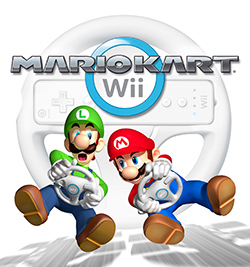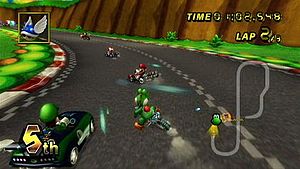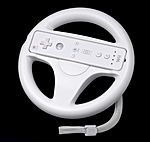Mario Kart Wii facts for kids
Quick facts for kids Mario Kart Wii |
|
|---|---|

|
|
| Developer(s) | Nintendo EAD |
| Publisher(s) | Nintendo |
| Director(s) | Yasuyuki Oyagi |
| Producer(s) | Hideki Konno |
| Designer(s) |
|
| Programmer(s) |
|
| Artist(s) | Daisuke Kageyama |
| Composer(s) |
|
| Series | Mario Kart |
| Platform(s) | Wii |
| Release date(s) |
|
| Genre(s) | Kart racing |
| Mode(s) | Single-player, multiplayer |
Mario Kart Wii is a super fun kart racing game made by Nintendo for the Wii console. It came out in April 2008. This game is the sixth one in the awesome Mario Kart series.
In Mario Kart Wii, you get to pick from 24 different characters from the Mario games. You race on 32 exciting tracks. You can use special items to slow down your friends or get ahead yourself!
The game has modes for playing by yourself or with others. You can even play with up to four friends on the same screen! There used to be online multiplayer, but that service ended in May 2014. Mario Kart Wii also brought back the popular Battle Mode. In this mode, you try to pop other players' balloons using power-ups.
Mario Kart Wii uses the Wii Remote's motion controls. This means you can steer your kart by tilting the controller like a real steering wheel! The game even came with a Wii Wheel accessory. This plastic wheel holds your Wii Remote and makes it feel even more like you're driving.
The game was a huge hit! Critics liked its online mode, characters, and new ways to play. It sold over 37 million copies, making it one of the best-selling video games ever. It's also the second best-selling Mario Kart game, right after Mario Kart 8 Deluxe.
Contents
How to Play Mario Kart Wii
Mario Kart Wii is a kart racing game where you can play alone or with friends. You choose a character from the Mario world. Then, you race go-karts or motorbikes on tracks inspired by places in the Mario games.

You see the race from behind your vehicle, like you're right there! There are four ways to control your kart. The main way is using the Wii Remote with the Wii Wheel. You tilt the wheel to steer, which feels super cool. You can also use the Wii Remote with the Nunchuk, the Classic Controller, or even a GameCube controller. These let you steer with a joystick instead.
As you drive, you'll find item boxes on the track. These give you power-ups! You can use them to attack opponents, defend yourself, or get a speed boost.
Characters and Vehicles
Mario Kart Wii has 24 playable characters from the Mario series. This was the biggest group of characters in a Mario Kart game until Mario Kart 8 came out in 2014. Some characters like Baby Peach, Baby Daisy, Rosalina, Funky Kong, and Dry Bowser made their first appearance in a Mario Kart game here!

Characters are put into three weight classes. This affects which vehicles they can drive. Mario Kart Wii also added a new type of vehicle: Bikes! Bikes come in two types: regular and sports bikes. Sports bikes have a special drift style called "inside drifting." You can even play as your own Mii character from the Mii Channel!
There are 36 different vehicles in the game. Each one handles a little differently. Many characters, vehicles, and tracks are hidden at first. You have to complete certain goals to unlock them!
Race Tracks
The game has eight "cups," and each cup has four different tracks. That's a total of 32 unique tracks! Just like Mario Kart DS, Mario Kart Wii has 16 brand new courses and 16 courses that are brought back from older Mario Kart games.
Game Modes
Mario Kart Wii has several exciting game modes:
- Grand Prix: You race in four three-lap races from one of the eight cups. You compete against eleven computer-controlled opponents. You get points based on how well you finish each race. The total points decide your overall rank.
- Time Trials: In this mode, you try to finish a race as fast as possible. There are no opponents or items, except for three Mushrooms you get at the start. You can even race against a ghost character, which shows you how you drove in an earlier race.
- Versus: This mode is like Grand Prix, but you can choose which courses and items appear.
- Battle Mode: This is a fun mode where players drive around a closed area and attack each other with items. Players are split into two teams, red and blue. Your teammates can't hurt you with their items.
Battle Mode Types
There are two types of Battle Mode:
- Balloon Battle: Each player's kart has three balloons. You get a point for popping or stealing an opponent's balloon. You lose a point if you lose all your balloons.
- Coin Runners: Players collect coins scattered around the arena. You can attack opponents to make them drop their coins. The team with the most points or coins when the three-minute timer runs out wins!
Battle Mode has ten different arenas, including five new ones and five from past Mario Kart games.
Online Play (Past Feature)
Online play was available through Nintendo Wi-Fi Connection until May 20, 2014. You could play Versus and Battle modes with up to 12 people. Up to two players could even play from the same Wii console online! You could race against random players or just your friends. After each race, your VR (versus rating) or BR (battle rating) would change based on how you did. The Mario Kart Channel also showed online rankings for Time Trials and special monthly tournaments.
Making of Mario Kart Wii

Mario Kart Wii is the sixth game in the Mario Kart series. It came after Mario Kart DS. Hideki Konno was the producer for this game. He also worked on the first two Mario Kart games and Mario Kart DS. Shigeru Miyamoto, a famous game designer, was the "General Producer" and gave advice.
The creators wanted to add features that they couldn't fit into Mario Kart DS. They also made online play better. For example, they changed how online races worked so new players could join a race once it finished, ready for the next one.
Mario Kart Wii was the first game in the series to let you drive BMX motorbikes. Hideki Konno had wanted to add bikes since Double Dash because he liked extreme sports. But the idea of Mario on a bike seemed too strange back then! The game was even called "Mario Kart X" for a short time during development, with "X" standing for "extreme."
Announcing the Game
Mario Kart Wii was officially announced at E3 2007, a big video game event. They showed the online features and the first video of the game there. A trailer showed new characters and tracks. It also revealed that up to 12 racers could play at once! More details came out in October 2007, where they confirmed bikes and the Wii Wheel. The release date was set for spring 2008.
Designing the Wii Wheel
To make the motion controls special, a plastic, wheel-shaped case for the Wii Remote was included with some versions of the game. The designers tried out about 30 different ideas for the wheel! They tested different shapes, colors, and weights. The final design was made to be super lightweight so it would be comfortable to hold for a long time. It was made all white to match other Wii accessories. A blue ring with the Wii logo was put on the back of the wheel. This blue ring even ended up in the game's logo!
Music and Sound
The music for the game was created by Asuka Hayazaki and Ryō Nagamatsu. They used new versions of familiar tunes from older games, plus brand new songs. The speaker on the Wii Remote is often used during gameplay to make cool sound effects. The developers even had the voice actors play the game while recording their voices!
Legacy and Fan Creations
Even though official online play ended in 2014, fans have found ways to bring it back! Unofficial video game mods like Wiimmfi let players enjoy online races again.
CTGP-R is another popular mod made by fans. It adds even more courses and new features. For example, it allows 24-player races and includes the 200cc engine class from Mario Kart 8 (2014). It also has extra modes like Countdown and Item Rain.
See also
 In Spanish: Mario Kart Wii para niños
In Spanish: Mario Kart Wii para niños

